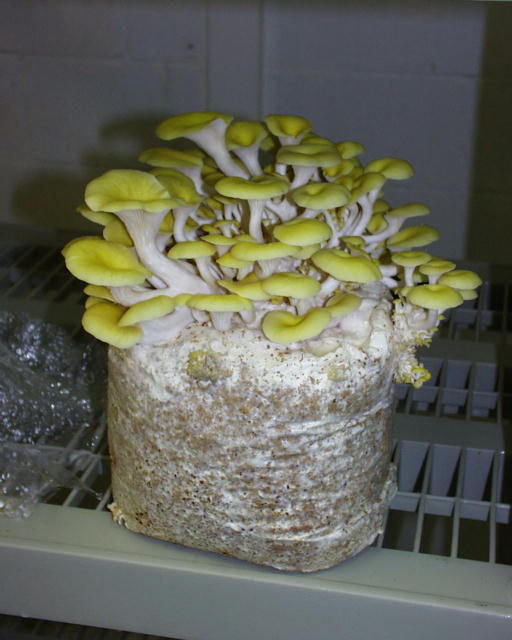
Golden Trumpet mushrooms grown by the peroxide method at White Rock Creek Mushrooms in Hillsboro, Texas. Photo courtesy of Joe Durham.
Yes. Volume II of the peroxide manual presents two peroxide methods for preparing bulk mushroom substrate in any quantity at room temperature. These methods are well suited to commercial cultivation. Both volumes of the manual present peroxide methods for maintaining tissue cultures, storing strains, and preparing mushroom spawn, all crucial aspects of commercial cultivation as well.For a video clip of the peroxide method in action at a commercial mushroom-growing operation in Mexico, go here.
Pellet fuel costs about $3.00-4.00 retail per 40 lb. bag in my area of the US, but it is also possible to get discounts for large quantities, and I have bought oak pellet fuel for $120 a ton (50 bags). This works out to about $0.06 a pound dry weight, or $0.12 to $0.14 per mushroom block. This is a significant expense if you can get sawdust for free. However, if you are using pellet fuel with peroxide, you can use ordinary trash bags to hold your substrate, rather than the special heat resistant space bags usually used for pressure cooking sawdust. I pay $0.04 each for trash bags from the grocery store, whereas heat resistant bags cost anywhere from $.80 each (if you buy just a few for hobby use), down to $0.15 each (if you buy them in great quantities for commercial use). In addition, with boiling water pasteurization of pellet fuel, you avoid lengthy pressure sterilization (or lengthier steaming), so your energy costs are very low. Your amortized cost of equipment is also very low, especially compared to the costs of air filtering equipment and pressure cookers, autoclaves, or steam chambers. Finally, you can easily make your own spawn without a laboratory using the peroxide method, perhaps saving you the cost of the lab or the purchase price of spawn ($10 to $20 for every five to six pounds).
All told, my blocks cost about $0.33 each, including pellet fuel ($0.14), lime ($0.01), supplements ($0.06), peroxide ($0.05), my own spawn ($0.02), bags ($0.04), and energy use ($0.01?). This compares to estimates I have seen ranging from $1.25 to $2.50 per block for shiitake cultivation with traditional methods (for example, Albert Bates of Mushroom People wrote an article on shiitake production for the Fungus Digest--now defunct--that estimated $2.50 per block). Perhaps some of this difference should be balanced against the experimental nature of the peroxide substrates, which may take time to optimize for yields comparable to traditional substrates. But this in turn should be balanced against the reduced contamination rate that can be expected using peroxide, even when compared to commercial set-ups using expensive contamination control systems.
You may freely copy and distribute the information on this webpage to friends or colleagues, as long as you include the following notice:
This document is Copyright: ©1999 by Randall R. Wayne, Ph.D. All commercial rights are reserved. No part of this work may be reproduced or used for sale in any form or by any means without permission of the author.

